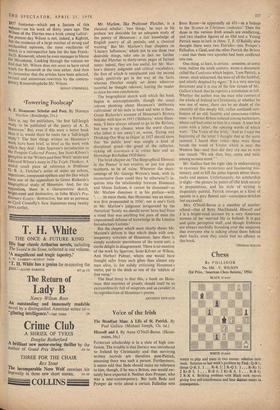Voice of the Irish
The Steadfast Man: A Life of St. Patrick. By Paul Gallico. (Michael Joseph, 12s. 6d.) PATRICIAN scholarship is in a state of high con- fusion. The trouble is that literacy was introduced to Ireland by Christianity and that surviving written records are therefore post-Patrick, assuming there was such a person. Furthermore, it seems odd that Bede should make no reference to him, though, if he was a Briton, one would cer- tainly have expected it. Neither does Prosper, who was a near-contemporary. But both Bede and Prosper do write about a certain Palladius sent from Rome—in apparently AD 431—as a bishop to the 'Scottos in Christum credentes.' Then the dates in the various Irish annals are conflicting, and two shadow figures of an Old and a Young Patrick seem to lurk in them. T. F. O'Rahilly also thought there were two Patricks—one Prosper's Palladius, a Gaul, and the other Patrick the Briton —and that these two apostles had been conflated into one.
One thing, at least, is certain : someone, at some time, before the ninth century. wrote a document called the Confessio which begins, 'I am Patrick, a sinner, most unlearned, the least of all the faithful, and utterly despised by many.' It is a very moving document and it is one of the few virtues of Mr. Gallico's book that he reprints a translation in full.. Whether the author was the man who converted the whole-of Ireland to Christianity or whether he was one of many, there can be no doubt of the sincerity of this deeply felt, rather confused con- fession of an old, humble and conscience-ridden man—a Roman Briton isolated among barbarians, whose call had come to him in a vision. A man had come with a letter, the opening words of which were : 'The Voice of the Irish."And as I read the beginning of the letter I thought that at the same moment I heard their voice—they were those beside the wood of Vociut which is near the Western Sea—and thus did they cry out as with one mouth "We ask thee, boy, come and walk among us once more."' Mr. Gallico had the right idea in endeavouring to re-create this mysterious and fascinating mis- sionary, and to kill the pious legends about sham- rocks and snakes. Unfortunately, his scholarship is slight—the picture he paints of Old Irish society is preposterous, and his style of writing is exquisitely painful. Patrick emerges as a kind of apostle in a grey flannel suit—conscience-stricken but successful.
Mrs. O'Neill-Barna is a member of another school—that of Betty MacDonald. Himself and 1 is a bright-eyed account by a very American woman of her married life in Ireland. It is gay and quite perceptive stuff, and though Irishmen are always morbidly brooding over the suspicion that everyone else is talking about them behind their backs, even they could find no offence in this book.
THOMAS HOGAN














































 Previous page
Previous page